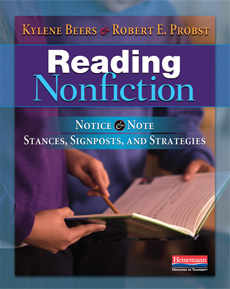Inspiring Information – a Nonfiction Reading List
Unless you’re a modern day Leonardo da Vinci, I’m sure you’ve faced a topic or unit that you were required to teach that didn’t cause an instant burst of enthusiasm. It’s perfectly natural, but I’ve found that teaching and learning require passion – genuine passion as children can detect phony from fifty yards away. When I don’t have that natural enthusiasm, I look for ways to generate it in myself. I’m sharing my process for tackling a unit that I don’t have a natural love for in this series of posts. I’m looking at you, nonfiction.
Once I take a good hard look at the unit and myself, it’s time to dive in and learn more from people who are enthusiastic and passionate about the topic. Reading has never failed me, and there are phenomenal teacher authors who mentor me through their words – some I go back to time and again, some new who can shed additional light on a subject. I want to share with you these writers, and hope they can help you as they have helped me.
I started my teaching life as a history teacher, and found my way to Janet Allen. She writes in a real and honest way that has always made me feel that we were discussing strategies over a cup of coffee. Her works are a winning combination of a realistic assessment of some of the problems we face in literacy instruction combined with strategies that can be put in to place immediately. I know there will be strategies and ideas in these texts that will help me plan my unit.
My issue, though, isn’t planning, but passion. So I turn to Kylene Beers and Bob Probst of Notice and Note fame. If you haven’t read Notice and Note, stop reading this post and order it immediately. (Or ask your literacy coach, they probably have a copy. ) They have been teachers, they have worked with teachers, and they also write in a very accessible way. They have a passion for all things reading and in helping children become better readers and you can feel that in their writing. It is impossible to not become enthusiastic.
In this work Beers and Probst work to define nonfiction, discuss how nonfiction reading has different requirements of the reader than fiction, and identify “signposts” that should tell the reader when to stop and, well, “notice and note”. The signposts are the real meat of the book, and it includes model lessons for each signpost as well. Well worth reading and discussing, I recommend it!
Once I have gone to my print mentors and immersed myself in a topic like this, I can’t help but become excited to teach it. Who are your favorite print mentors for nonfiction reading?




Leave a comment